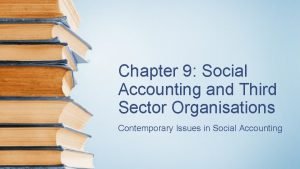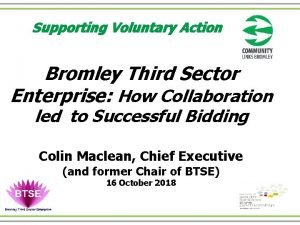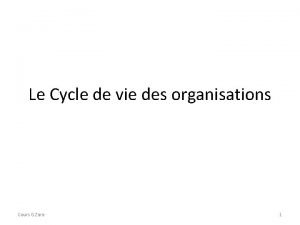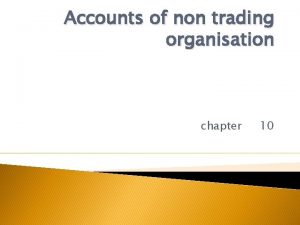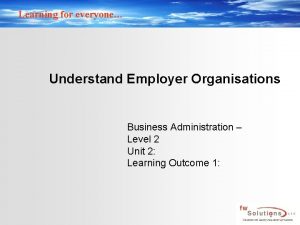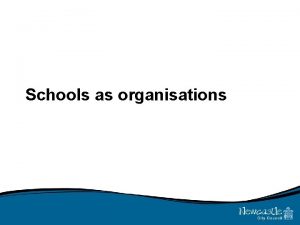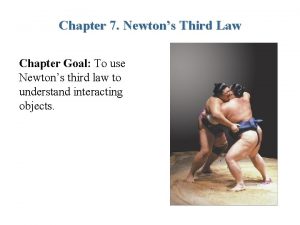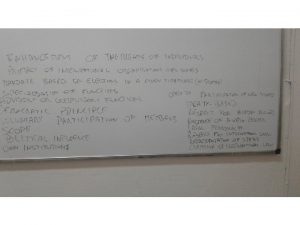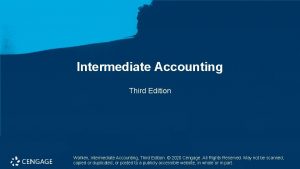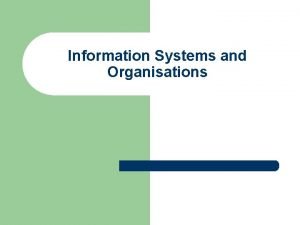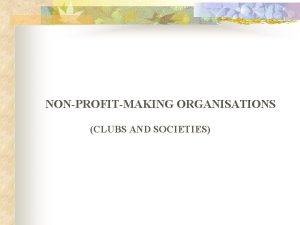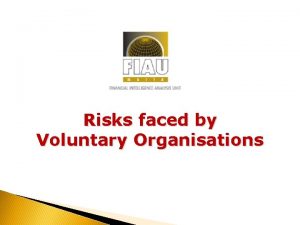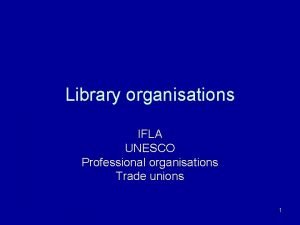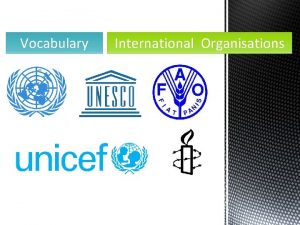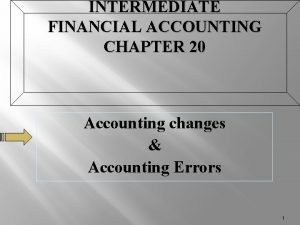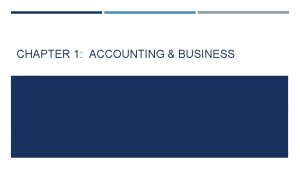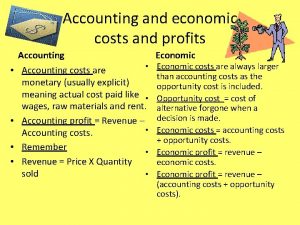Chapter 9 Social Accounting and Third Sector Organisations







































- Slides: 39

Chapter 9: Social Accounting and Third Sector Organisations Contemporary Issues in Social Accounting

Chapter Structure • Introduction • The nature and purpose of Third Sector Organizations (TSOs) • The importance of TSOs in the modern economy • Reporting practices and governing challenges in TSOs • Governing Practices in TSOs • Accountability in TSOs • Summary • Additional reading materials 2

The nature and purpose of Third Sector Organizations • The mission of the Gavi - Vaccine Alliance is to “sav(e) children’s lives and protect people’s health by improving the availability of vaccines in lower-income countries”. – Civil society organizations play a key role in advancing Gavi’s vision and mission. 3

The nature and purpose of Third Sector Organizations • The United Nations (UN) defines the “civil society” as the “third” sector (TS) in terms of economic activity, placing it alongside the first and second sectors. • Third sector – Do not aim for profit and profit distribution, – They are self-governed, – Social impact is the main measure of success, – Based on donations and voluntary work. 4

The nature and purpose of Third Sector Organizations • TSOs consist of: – – – Community groups, Voluntary organizations, Charities, Social enterprises, Co-operatives Business forums, Faith based associations, Labour unions, Philanthropic Foundations, Think tanks. 5

The importance of TSOs in the modern economy • Over the past 30 years, the importance and influence of civil society in economic and social activity has increased. • Reasons: – TSOs are instrumental in promoting democratic governance and efficient public administration in developing countries. – TSOs are key drivers in the efficient design and implementation of development and financial aid programmes. 6

The importance of TSOs in the modern economy • Reasons (cont. ) – The European welfare social model is challenged. – Public Sector’s ability is criticized over its ability to deliver financially sustainable social services. – Capacity for innovation and engagement with local communities, as well as the ability to serve citizens facing more complex problems, seem to create the point of differentiation for TSOs in delivering social services in partnership with public sector organizations 7

The importance of TSOs in the modern economy • The impact of TSOs on private sector: – TSOs improve labor skills and quality of workforce, – TSOs create job opportunities, – TSOs promote trust, innovation and entrepreneurship, – TSOs induce a new ethos in commercial activities and influence consumers’ preferences. 8

Reporting practices and governing challenges in Third Sector Organizations • In the UK charities are expected to produce annual reports and accounts that transparently demonstrate the sources and uses of funds. • The UK Accounting Standards Board (ASB) regulates financial reporting practices for charities, and it supports the application of reporting standards by issuing Statements of Recommended Practices (SORPs). 9

Reporting practices and governing challenges in Third Sector Organizations • Financial accounts are prepared on the basis of accrual accounting. • Audited financial statements – Statements of financial activities, – Balance sheet, – Cash flow statement, – Notes to the accounts, – Annual report. 10

Reporting practices and governing challenges in Third Sector Organizations • Reporting challenges – Small charities. – Tend not to meet the minimum reporting standards. – Large charities. – Financial reports meet regulatory standards. – Financial reports are regularly examined or audited by independent bodies. – However, they fail to make apparent and disclose evidence on how the activities performed made a difference to their beneficiaries. 11

Reporting practices and governing challenges in Third Sector Organizations • Management challenges – Poor management, – Absence of professionalism, – Few efficiency measurements, – Lack of effective accounting practices that would enhance both accountability and transparency. 12

Reporting practices and governing challenges in Third Sector Organizations • Overhead Myth – Non-profits and charities are mission and value driven organizations; their existence and funding are based on relationships built upon trust and in association with donors who will respond negatively when organizational resources are spent on salaries and administrative expenses. – Donors tend to criticize overhead spending and reward charities with minimal overhead costs. 13

Reporting practices and governing challenges in Third Sector Organizations • Overhead Myth (cont. ) – The percentage of charities’ overhead expenses to fundraising activities, is considered by donors as a key indicator of how effective a nonprofit organization uses the cash raised from donations. – Poor accountability and control are attributed to higher overhead costs. 14

Reporting practices and governing challenges in Third Sector Organizations • Overhead Myth (cont. ) – The validity of using solely financial measurements in evaluating the performance of TSOs in delivering their objectives have been challenged. – Underinvestment in infrastructure may result in lower operating standards, serving fewer beneficiaries by sustaining a smaller network and collecting fewer grants by not being able to identify potential donors. 15

Reporting practices and governing challenges in Third Sector Organizations • Nonprofit Starvation Cycle – The term used to describe a vicious cycle of persistent underfunding of overhead costs, with the outcome of donors’ unrealistic expectations of civil organizations to deliver more with less. – This predictable cycle ignores the fact that some overhead expenses are necessary and good for the organization and should, in fact, be seen as an investment in effective program delivery. 16

Governing Practices in Third Sector Organizations • The pressure exercised by funding institutions, including government agencies, donors and foundations on the TSOs to conform to the expectations for lower overhead expenses indicates conflicts of interest between principals and agents. • This principal-agent relationship may concern the interaction between trustees and managers or the interaction between donors and trustees. • Agents have been assigned the responsibility of managing transparency and the effective management of funds that civil organizations raise. 17

Governing Practices in Third Sector Organizations • From an agency theory perspective, the prioritization of financial metrics in measuring performance indicates the effort of principals-donors to keep agent-managers/trustees accountable for meeting the mission and scope of the charity. • Financial metrics employed for making the use of donations transparent and enhancing the trust of donors on the way charities raise and use funds. 18

Governing Practices in Third Sector Organizations • Evidence exists that in the non-profit sector, the board of trustees exercises weak control over the behaviour of managers. • Moreover, they find it difficult to oversee all services provided by the organization. 19

Governing Practices in Third Sector Organizations • Governance – Good governance is founded on a clear mission, organizational structure and decision-making processes. – When activities performed are in alignment with the values and processes of the organization, outcomes are consistent with its mission and reporting complies with the required reporting standards. 20

Governing Practices in Third Sector Organizations • Governing Principles: – an effective board will provide good governance and leadership by members understanding their role, – ensuring delivery of organizational purpose, – working effectively both as individual and a team, – exercising effective control, – behaving with integrity, – being open and accountable. 21

How these lenses impact Accountability in the TS • Black-hole of Accountability: – misappropriation of resources to corruption, – high administrative costs, – high executive compensations, – wealth accumulation, – commercialization, – inability to effectively achieve their mission. 22

How these lenses impact Accountability in the TS • Roles of Accountability: – legitimacy – overall performance – credibility to their donors and beneficiaries – independence 23

How these lenses impact Accountability in the TS • Types of Accountability: – Upward – Downward – Horizontal 24

How these lenses impact Accountability in the TS • Upward, Hierarchical or Functional Accountability: – Donors, foundations, partnering TSOs or government agencies often require them to provide formal accounting of how the resources at their disposal were used – Outline the immediate impact of their services. – enables funders to assert significant financial, governance and/or policy control by demanding accountability for the services provided. – Assess the efficiency of the funds donated based on pre-determined performance metrics 25

How these lenses impact Accountability in the TS • Why does Upward Accountability matter? – tax exemption status – access to governmental and humanitarian aids – prevent fraud – Ensure that they are not profit oriented. 26

How these lenses impact Accountability in the TS • Tools for Upward Accountability? – Annual reports, interim reports performance assessment reports and performance evaluation reports • Criticisms of Upward Accountability? – accountability mechanism has proven counter-productive by damaging the delivery of their services to those they are intended to benefit 27

How these lenses impact Accountability in the TS • Downward Accountability: – the need for TSOs to share the financial and social impacts of the services they provide with their beneficiaries and the communities they serve – used to assess the needs of TSO beneficiaries and to understand whether those needs have been addressed with the services rendered 28

How these lenses impact Accountability in the TS • Why does Downward Accountability matter? – humanitarian aids delivered did not reflect the humanitarian needs of the survivors – beneficiaries have no feedback/accountability mechanism to access the suitability of the services they received 29

How these lenses impact Accountability in the TS • Tools for Downward Accountability? – participatory dialogues, participatory evaluations and social audits to monitor performance and to establish accounting information systems – participatory rural appraisal visits and participatory learning and action initiatives that could include surveys, public meetings, or a formal dialogue on projects 30

How these lenses impact Accountability in the TS • Criticisms of Downward Accountability? – Consultative approach to downward accountability does not necessarily imply inclusive and effective engagements with beneficiaries – Inadequate in incorporating beneficiaries’ needs and views prior to the design and the implementation projects. – Validate the views of their funders, rather than reflect the opinions and views of their beneficiaries 31

How these lenses impact Accountability in the TS • Holistic Accountability: – addresses the accountability relationships of TSOs with its broader and to its mission statement – encompasses a broader form of accountability than upward or downward accountability – include qualitative and quantitative measures of the short and long-term impacts of the TSOs actions to multifaceted stakeholders 32

How these lenses impact Accountability in the TS • Why does Holistic Accountability matter? – Upward and downward accountability as a subset of holistic accountability – Emphasis on the moral responsiveness to the needs of their beneficiaries – Emphasis on the moral inclusiveness of their beneficiaries in decision making – TSOs’ responsibilities to its donors and government. – TSOs’ responsibilities to its partners. – TSOs’ responsibilities to its mission statement 33

How these lenses impact Accountability in the TS • Tools for Holistic Accountability? – participatory evaluation, stakeholders’ forum and surveys, – partnership with beneficiaries to develop and implement their programs – storytelling which enable beneficiaries to describe their experiences and perceptions of the activities of the organization. – striving to address its overall functional accountability to its donors and government 34

Summary – purpose of improving the lives of others and solving social problems. – provide social services in countries where the public sector is deemed inefficient – Accountability to financial contributors, volunteers and beneficiaries is high on their agenda – Accountability, is important for legitimizing purposes. 35

Summary (Cont. ) – Tax exemption status – Upward forms of accountability – Downward accountability – Holistic accountability 36

37

Additional reading materials • Agyemang, G. , Awumbila, M. , Unerman, J. and O’Dwyer, B. (2009). NGO Accountability and aid delivery. London: Certified Accountants Educational Trust. • Association of Chief Executives of Voluntary Organizations (2010) Good Governance: A code for the voluntary and community sector [online], 2 nd ed. , revised, available: http: //greyhoundrescuewales. co. uk/wpcontent/uploads/2015/09/Code-of-Governance-Full 1 -copy-2. pdf • Bedsworth, W. Goggins, A. G. and Howard, D. (2008). Nonprofit Overhead Costs: Breaking the Vicious Cycle of Misleading Reporting, Unrealistic Expectations, and Pressure to Conform, The Bridgespan Group (April), available: www. bridgespan. org 38

Additional reading materials (cont. ) • Boomsma, R. and O’Dwyer, B. (2014). The nature of NGO accountability, conceptions, motives, forms and mechanisms. In: J. Bebbington, J. Unerman and B. O’Dwyer (2 nd ed. ), Sustainability, Accounting and Accountability, pp. 157175. Oxon: Routledge. • Burger, R. and Seabe, D. (2014). NGO Accountability in Africa. In: E. Obadare (ed. ). The handbook of civil society in Africa, pp. 77 -94, New York: Springer. • Charities and Trustee Investment (Scotland) Act 2005, The Charities Accounts (Scotland) Regulations [online], Scottish Statutory Instruments, No. 218, (May 17, 2006), available: www. legislation. gov. uk/ssi/2006/218/pdfs/ssi_20060218_en. pdf 39
 Higher business management
Higher business management Role of business in society
Role of business in society What is the third sector of the economy
What is the third sector of the economy Bromley third sector enterprise
Bromley third sector enterprise Gingival third vs cervical third
Gingival third vs cervical third Odontoclasia definition
Odontoclasia definition Financial accounting and accounting standards chapter 1
Financial accounting and accounting standards chapter 1 Contemporary organisations
Contemporary organisations Oms 2018
Oms 2018 How humans behave in organisations
How humans behave in organisations Psychologie du travail et des organisations dolan
Psychologie du travail et des organisations dolan Cycle de vie de l'entreprise selon greiner
Cycle de vie de l'entreprise selon greiner Receipt and payment account
Receipt and payment account End point assessment register
End point assessment register Understand employer organisations
Understand employer organisations Functional areas in business organisations
Functional areas in business organisations Communication socionumérique des organisations
Communication socionumérique des organisations Psychosociologie des organisations
Psychosociologie des organisations Schools as organisations
Schools as organisations Explorer les organisations du monde
Explorer les organisations du monde Public sector accounting lecture notes in kenya
Public sector accounting lecture notes in kenya Recording transactions in a journal
Recording transactions in a journal What is third party referral in health and social care
What is third party referral in health and social care Social thinking adalah
Social thinking adalah Social thinking social influence social relations
Social thinking social influence social relations Social xchange
Social xchange Function of group dynamics
Function of group dynamics Conclusion of computerized accounting
Conclusion of computerized accounting Going concern principle
Going concern principle Social accounting ppt
Social accounting ppt Social accounting and audit
Social accounting and audit Social darwinism vs social gospel
Social darwinism vs social gospel Chapter 7 newton's third law of motion
Chapter 7 newton's third law of motion Conceptual physics chapter 5 newton's third law of motion
Conceptual physics chapter 5 newton's third law of motion Conceptual physics chapter 5 newton's third law of motion
Conceptual physics chapter 5 newton's third law of motion Chapter 2 lesson 4 newton's third law answer key
Chapter 2 lesson 4 newton's third law answer key Chapter 12 section 3 newton's third law answer key
Chapter 12 section 3 newton's third law answer key Slightly tilted wings of airplanes deflect
Slightly tilted wings of airplanes deflect Chapter 7 newton's third law
Chapter 7 newton's third law Site:slidetodoc.com
Site:slidetodoc.com


